The world recognizes Moroccan cuisine for its bold and complex flavors rooted in its spices. Moroccan spices, such as the fiery harissa and subtle cinnamon, contribute to the cuisine’s depth, richness, and complexity. Moroccans have valued these aromatic ingredients for centuries, reflecting their importance in Moroccan culture and history. In this article, we will explore the role of Moroccan spices in the country’s culinary heritage.
The Importance of Spices in Moroccan Cuisine
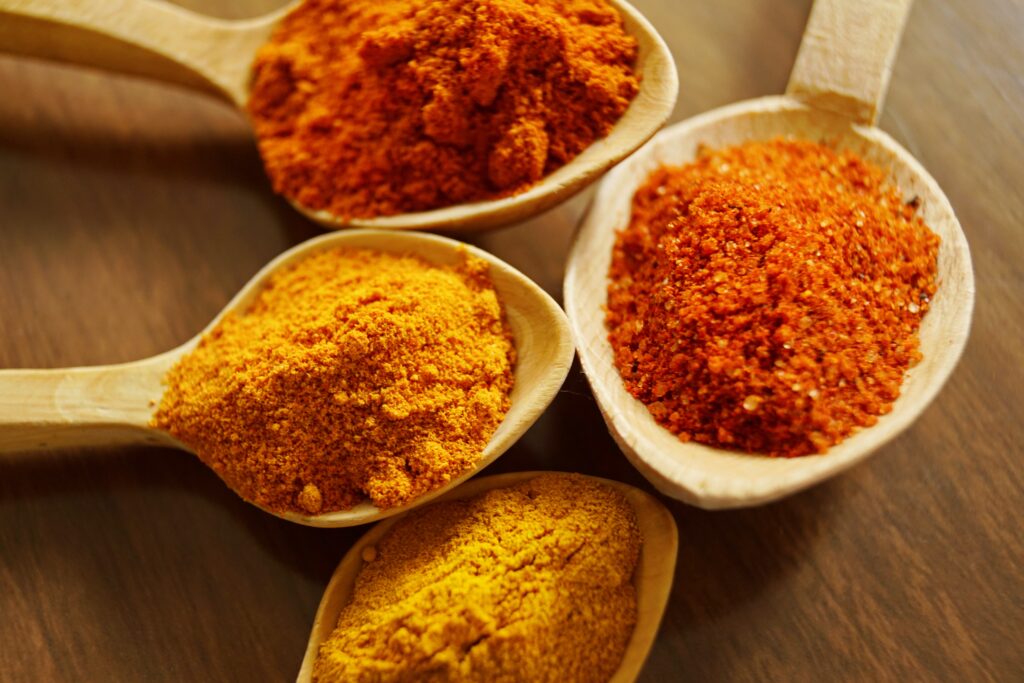
Spices are an essential part of Moroccan cuisine, and they play a significant role in shaping the unique flavors of this North African country. The use of spices in Moroccan cooking is so substantial that it’s hard to imagine Moroccan food without them. The combination of spices used in a dish makes it distinctively Moroccan.
The use of spices in Moroccan cooking dates back centuries, and the country’s long trade and cultural exchange history has influenced the range of herbs used in the country’s cuisine. The trade with India and Southeast Asia introduced many spices used in Moroccan dishes, such as cumin, coriander, and cinnamon, to the region.
People know Moroccan cuisine for its intricate spice blends containing up to 30 seasonings. Each seasoning has its unique flavor and aroma, and together they create a complex and harmonious blend that is the hallmark of Moroccan cuisine. From the sweet notes of cinnamon to the earthy flavors of cumin and the floral undertones of saffron, each spice adds a layer of complexity and depth to Moroccan dishes.
Moroccan chefs skillfully use spices to add depth and complexity to sweet and savory dishes, making Moroccan cuisine renowned. The aromatic blend of ras el hanout and the fiery kick of harissa are just a couple of examples of the variety of spices incorporated into the country’s creations. Classic dishes like tagines benefit from these spices by creating rich and flavorful sauces. In addition to spices, Moroccan cuisine heavily relies on herbs, which offer flavor and health benefits in addition to spices. People commonly use ginger to aid digestion, and they believe that saffron has mood-boosting properties. Whether enjoying a hearty tagine or indulging in a sweet pastry like baklava, Moroccan cuisine’s spices and herbs will surely delight your taste buds and invigorate your senses.
The History and Cultural Significance of Spices
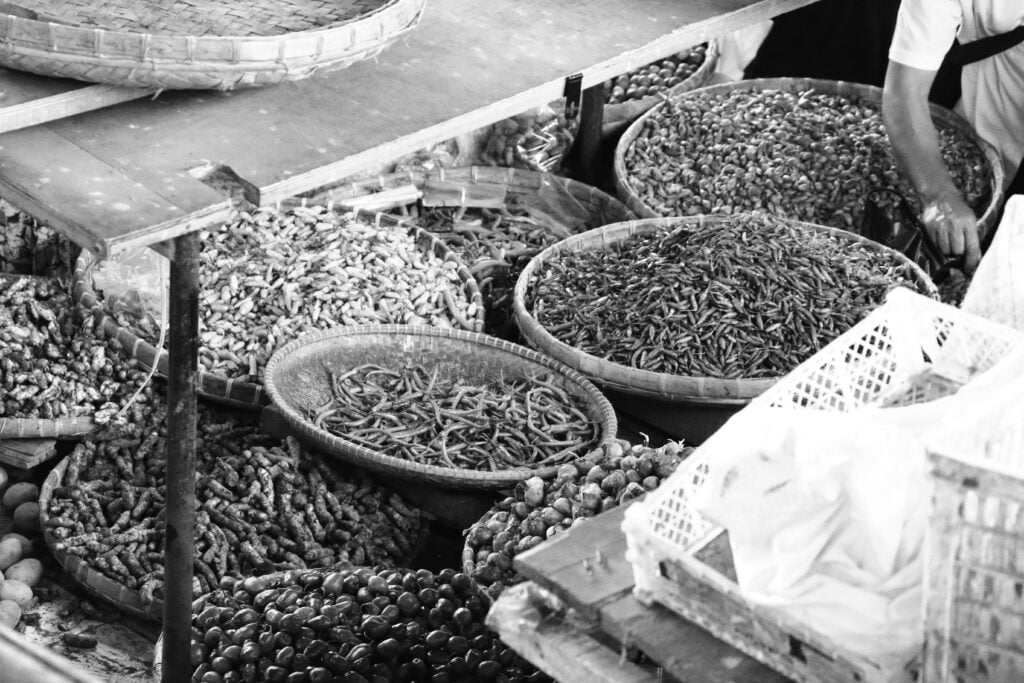
Morocco‘s rich history and culture have given rise to some of the world’s most significant contributions to cuisine, medicine, and spirituality in the form of its spices. Moroccan spices have been integral to the country’s traditions for centuries. In ancient times, the country’s strategic location on trade routes made it a hub for spice merchants who brought exotic flavors and ingredients from far-off lands.
To add depth and flavor to Moroccan cuisine, chefs use a complex blend of spices, including cumin, coriander, ginger, paprika, cinnamon, and saffron. These spices are often combined with herbs like parsley, cilantro, and mint to create a unique and layered taste that food enthusiasts worldwide love.
Not only do Moroccan spices enhance the flavor of dishes, but they also have various health benefits that enthusiasts recognize, including anti-inflammatory properties, digestive aid, immune system boost, and even weight loss promotion. Moreover, Moroccan herbs are an essential part of traditional medicine.
Moroccan spices are crucial to the country’s cuisine and spiritual traditions. Cumin, for instance, is believed to have protective properties, and people often use it in amulets to ward off evil spirits. Similarly, saffron holds high value for its powerful healing properties, making it one of the world’s most expensive spices.
Overall, Moroccan spices are a fascinating and integral part of the country’s history, culture, and cuisine. They are sought-after worldwide, and their unique flavors and health benefits remain essential to Moroccan life and traditions.
The Top 10 Spices Used in Moroccan Cooking
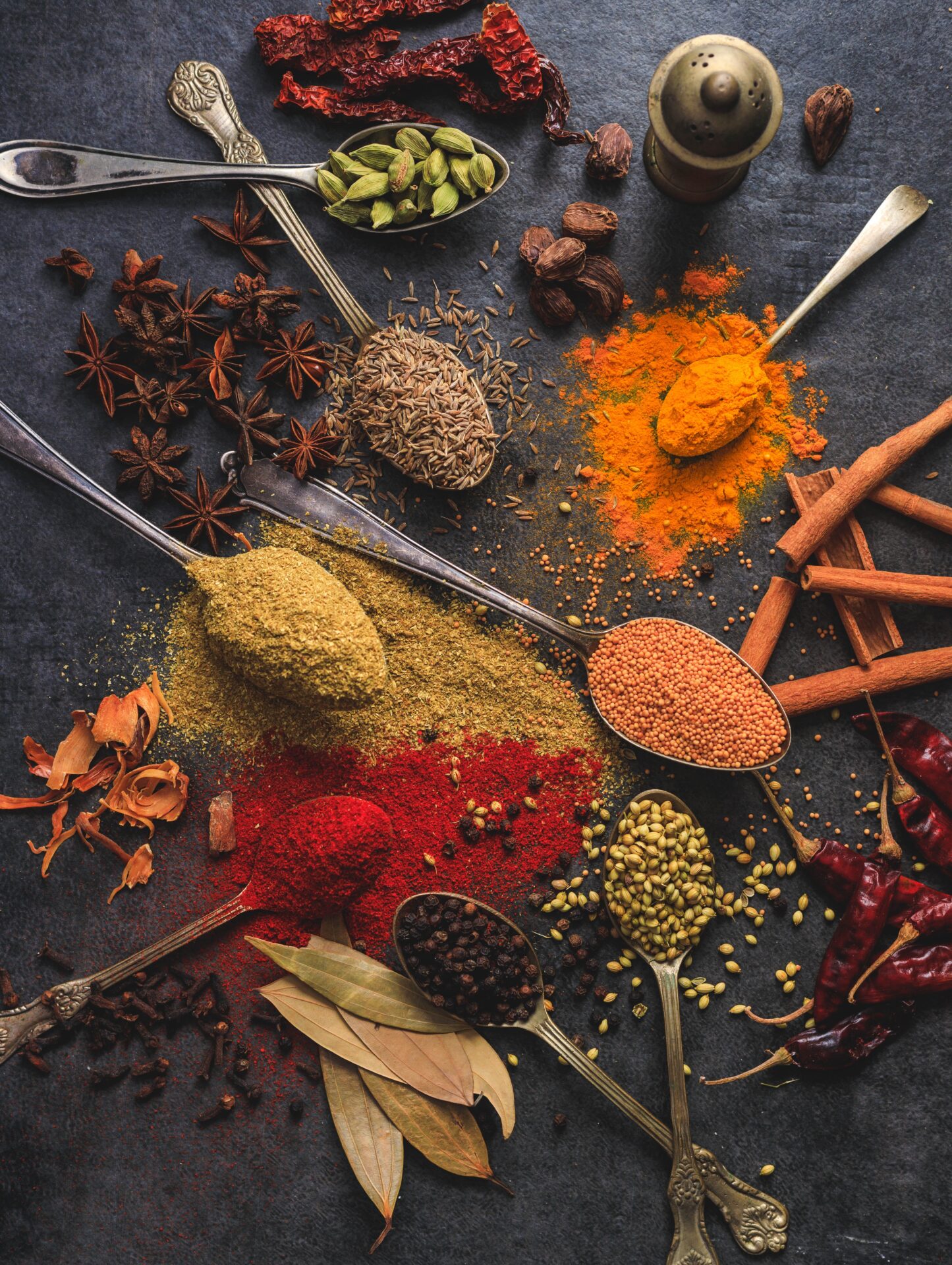
Moroccan cuisine boasts bold and exotic flavors, incorporating various spices known for their health benefits. Here are the top 10 herbs commonly used in Moroccan cooking:
First and foremost, cumin is a warm and earthy spice that is an essential part of Moroccan cuisine and prominently features in tagines, stews, and soups. Paprika, a sweet and smoky spice made from dried peppers, adds a vibrant red hue to dishes and is frequently used in meat and vegetable dishes. Ginger, a versatile spice with a warm and slightly spicy flavor, is a favorite in sweet and savory dishes.
Turmeric, a bright yellow spice with a slightly bitter flavor, is a common ingredient in Moroccan cuisine, particularly in spice blends like ras el hanout, which adds color and flavor to dishes such as couscous and tagines. Cinnamon, a sweet and fragrant spice, is also used in sweet and savory dishes, particularly tagines and couscous.
Saffron, the world’s most expensive spice, imparts a floral and slightly bitter flavor to dishes such as tagines and rice. Moroccan cuisine also incorporates slightly citrusy and nutty coriander seeds into spice blends like ras el hanout. Cilantro, the plant’s fresh leaves, is commonly used in Moroccan cooking.
Moreover, Moroccan cooks often use black pepper, which adds a spicy kick to their dishes and is a common ingredient in many kitchens. Cardamom, a fragrant spice with a slightly sweet and citrusy flavor, is often featured in sweet dishes such as pastries and desserts. Finally, Moroccan cuisine uses nutmeg in spice blends like ras el hanout to flavor sweet dishes like pastries and milk-based desserts.
Overall, using these ten spices in Moroccan cuisine is essential to the country’s rich culinary tradition, adding a unique and unforgettable taste to their dishes.
Understanding the Flavor Profiles of Moroccan Spices
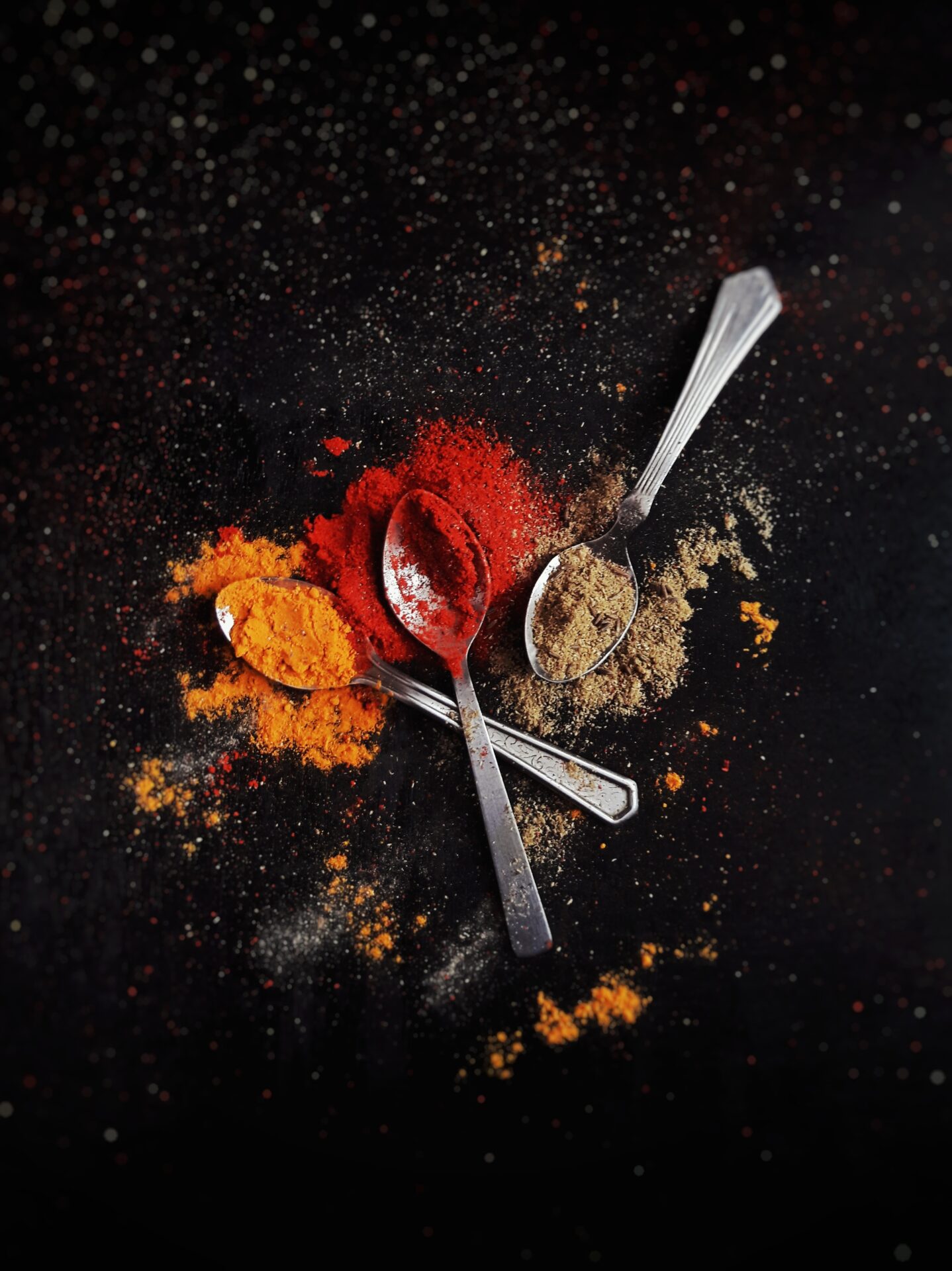
Spices are crucial in achieving the unique and complex flavors of Moroccan cuisine. Each herb adds a distinct taste, aroma, and color, making them essential ingredients in Moroccan cooking. Cumin is a crucial ingredient in Moroccan cuisine, contributing warmth and earthiness to dishes like tagines, stews, and spice blends such as ras el hanout. Paprika is another popular spice that adds bright red color and a slightly sweet, smoky flavor to marinades, rubs, and sauces.
Coriander is also a common herb in Moroccan cooking, with its subtle citrusy and slightly sweet taste. Cinnamon is often combined with cumin to flavor marinades and soups. Paprika, a sweet and smoky spice, adds depth to Moroccan dishes, including harira soup. Saffron, a highly prized and expensive spice, is used in many Moroccan dishes for its distinct flavors and vibrant yellow color, such as in paella and tagines. Ginger’s warm and spicy flavor is commonly used in tea and desserts, while turmeric’s slightly bitter and earthy taste is ideal for savory dishes.
Moroccan chefs use cinnamon’s sweet and woody flavor in many sweets and pastries while mixing coriander’s bright and citrusy taste in salads and marinades. They add cardamom’s strong and unique flavor to savory dishes like rice pilafs and tagines. By using spices for heat, taste, aroma, and color, Moroccan cuisine offers an exceptional culinary experience. Knowing how to pair the flavor profiles with ingredients and quantities is crucial in creating authentic Moroccan dishes.
The Health Benefits of Moroccan Spices
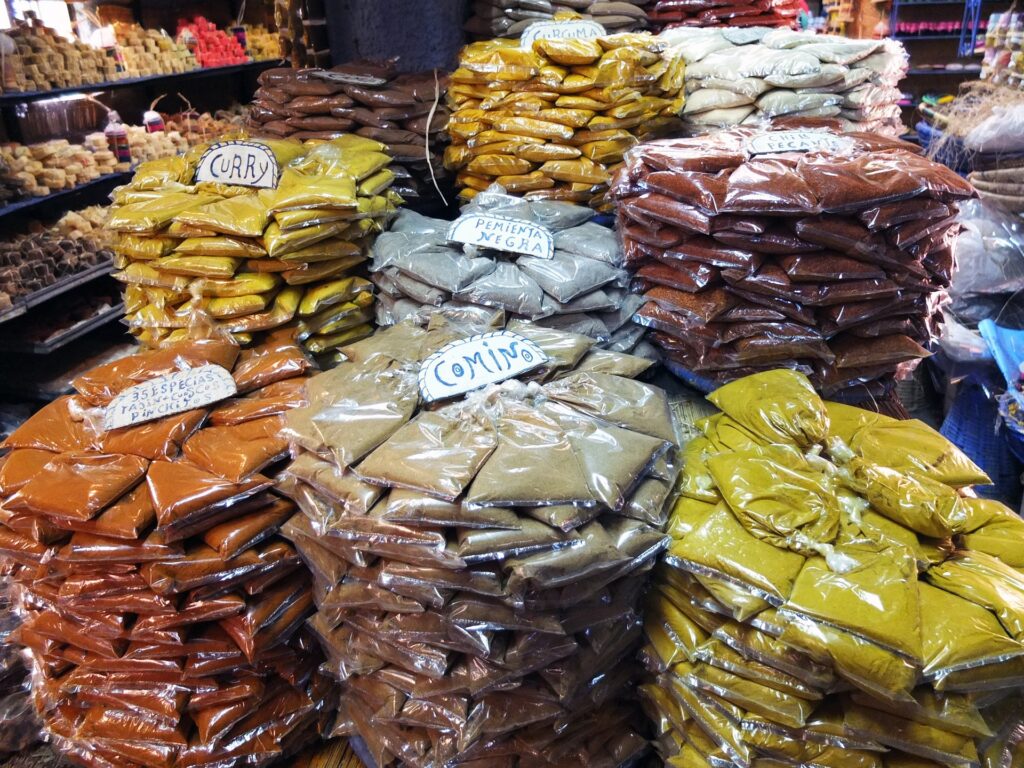
Moroccan cuisine is well-known for its rich flavors and aromatic spices. However, these spices offer more than just great taste; they also have many health benefits. Let’s examine the top herbs used in Moroccan cuisine and their benefits.
To begin with, cumin is a fundamental ingredient in Moroccan cuisine and a key component in spice blends like ras el hanout and baharat. Cumin adds warmth and earthiness to dishes and can also aid digestion, boost the immune system, and improve blood sugar levels.
Moving on, turmeric is a common ingredient in Moroccan stews and tagines due to its potent anti-inflammatory properties. This spice can alleviate joint pain, improve brain function, and reduce the risk of heart disease.
Ginger is another spice used in Moroccan marinades and sauces to add a spicy kick. Not only does ginger enhance flavor, but it also helps with nausea, reduces inflammation, and lowers cholesterol levels.
Furthermore, paprika is a versatile spice in savory and sweet dishes. It is a rich source of antioxidants with anti-inflammatory properties that can help with various health conditions.
Cinnamon is a popular spice used in Moroccan desserts and pastries, and it offers a range of benefits, such as regulating blood sugar levels, reducing inflammation, and improving brain function.
Coriander is a common ingredient in Moroccan spice blends and offers digestive benefits as well as potential heart health benefits.
Saffron is an expensive but valuable spice that can improve mood, alleviate PMS symptoms, and aid in weight loss.
Black pepper is another spice commonly used in Moroccan blends, like ras el hanout. It can aid digestion, improve brain function, and reduce the risk of certain cancers.
Lastly, cardamom is a popular spice used in Moroccan coffee and tea. It aids digestion, improves heart health, and freshens breath.
Incorporating these spices into your cooking will enhance your dishes’ flavor and provide numerous health benefits. So don’t be afraid to spice up your life with Moroccan cuisine’s delicious and nutritious flavor.
Using Moroccan Spices in International Cuisine
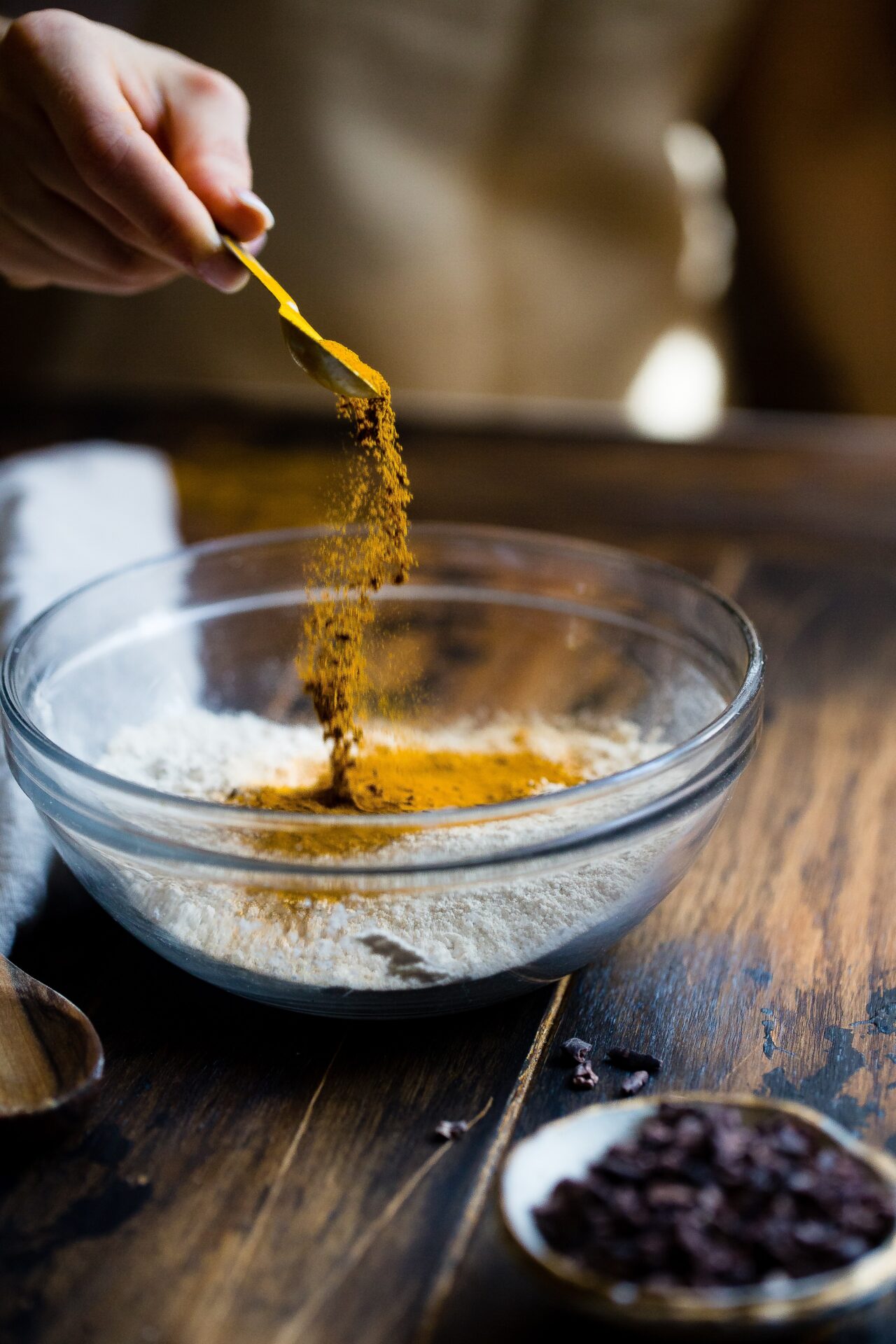
Moroccan spices have earned fame for their unique blend of flavors and aromas, which have become an integral part of the country’s cuisine. However, their versatility allows cooks to incorporate them into various international dishes, adding an exotic twist to familiar recipes. We will explore some creative ways to use Moroccan spices in international cuisine.
For example, try Moroccan Spiced Meatballs by adding cumin, coriander, and cinnamon to your meatball recipe for a bold new flavor. Alternatively, roast sweet potatoes, carrots, and red onions with paprika, turmeric, and ginger for a delicious and healthy side dish in Moroccan Spiced Roasted Vegetables. Serve with couscous or quinoa.
You can add cumin and paprika to make Moroccan-Spiced Hummus, an option for giving your Hummus a unique twist. For a flavorful twist on grilled chicken, marinate your chicken with ras el hanout and harissa in Moroccan-Spiced Grilled Chicken, and serve with roasted vegetables or salad. Serve with pita bread or fresh vegetables.
If you’re in the mood for a hearty and satisfying meal, try Moroccan-Spiced Lentil Soup by adding cumin, coriander, and turmeric to your lentil soup recipe. Serve with crusty bread. Finally, add saffron, ginger, and cinnamon to spice up your rice to create Moroccan-Spiced rice. Serve with grilled meats or roasted vegetables.
In summary, Moroccan spices are a versatile and flavorful addition to international cuisine. Experiment with different spice blends and dishes to create your unique culinary creations. Don’t be afraid to get creative and try new things, as the possibilities are endless.
Tips for Buying and Storing Moroccan Spices
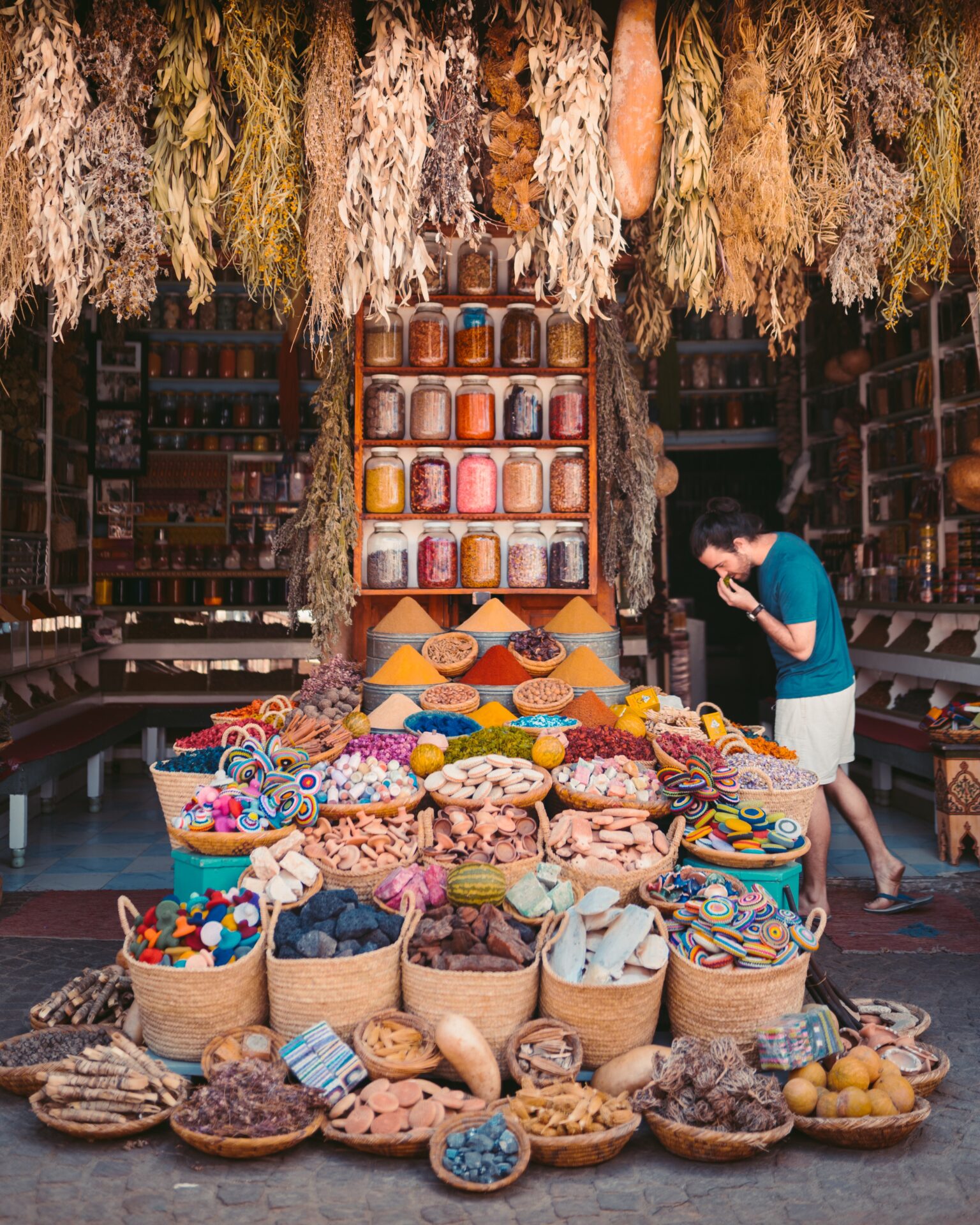
Moroccan spices are an integral part of the country’s cuisine, and many people worldwide enjoy their unique flavors and aromas. Whether you’re a home cook or a professional chef, it’s essential to understand how to buy and store these spices to maintain their flavor and freshness. We’ll share tips and tricks for buying and storing these spices.
Buy Whole Spices Whenever Possible
While Moroccan ground spices are widely available, buying whole spices is best whenever possible. Whole spices retain their flavor and aroma for longer, and you can quickly grind them as needed. Natural herbs also reduce the likelihood of adulteration or contamination, ensuring the spices are of the best quality.
Choose High-Quality Spices
Choose high-quality products from reputable brands or sellers when shopping for Moroccan spices. Look for fresh and fragrant herbs with vibrant colors and no signs of discoloration or mold. Be wary of cheap or discounted sauces, as they may be of lower quality or adulterated with other substances.
Store Spices Properly
Proper storage is crucial for maintaining the flavor and freshness of Moroccan spices. To achieve this, use airtight containers to hold the spices in a cool, dry location free of moisture, direct sunlight, and heat sources. Avoid storing spices in the refrigerator, as it can cause condensation and affect the flavor. To ensure freshness, label your herbs with the date of purchase and use them within six months to a year. This way, you’ll get the best flavor out of it.
Grind Spices as Needed
Grinding your spices allows you to customize the texture and intensity of the flavor to your liking. To get the most taste out of your Moroccan spices, scrape them as needed using a spice grinder or mortar and pestle. Before grinding, toast whole spices in a dry pan or oven to release their flavor.
Experiment with Combinations
Chefs often combine Moroccan spices to create complex and delicious flavors. Standard spice blends used in Moroccan cuisine include Ras El Hanout, Baharat, and Harissa. Experiment with different combinations of herbs to find your favorite blends.
Buying and storing the spices properly is vital. Choose high-quality whole spices and keep them properly. Grind the seasonings as needed and experiment with combinations to enhance your culinary creations. Enjoy the decadent and unique flavors of Moroccan cuisine.
Exploring Morocco’s Spice Markets and Souks
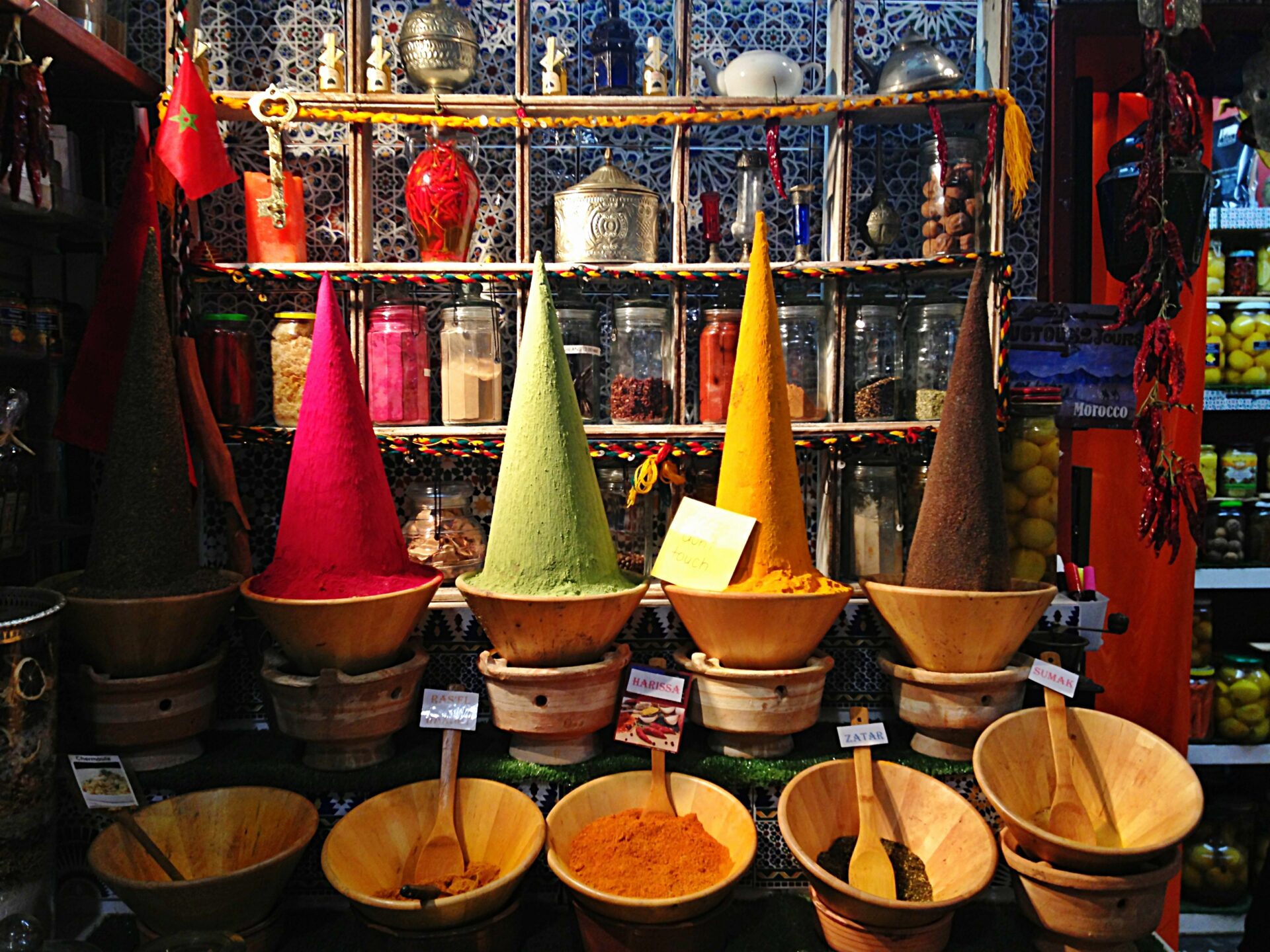
In Morocco’s spice markets or souks, you can experience a sensory feast. You’ll encounter bustling marketplaces full of exotic spice aromas, colorful herb displays, and lively vendors calling out to passersby. To explore these unique and immersive cultural experiences:
- Visit in the morning for the liveliest experience and freshest produce and spices.
- Come prepared with comfortable shoes, a bag or basket, and small cash denominations.
- Haggle for a reasonable price but with a smile and friendly attitude.
- Try samples before purchasing, especially if you are unfamiliar with a particular spice or herb.
- Ask for recommendations from vendors happy to share their knowledge and expertise.
- Enjoy the experience by soaking up the atmosphere and immersing yourself in the local culture.
Exploring Morocco’s spice markets is an opportunity to appreciate the importance of spices in Moroccan cuisine and experience the country’s rich culture and history.
Traditional Moroccan Spice Blends and Recipes
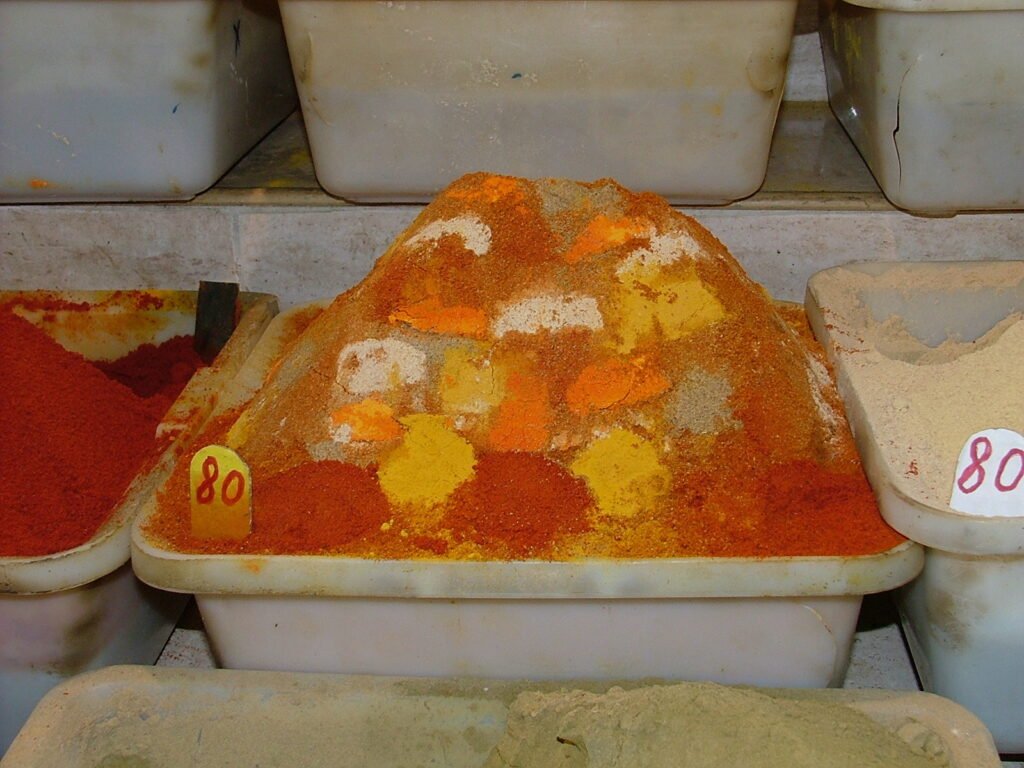
Moroccan cuisine elevates the taste of any dish with its flavorful and aromatic spice blends. The country’s culinary heritage relies on the traditional spice blends passed down for generations. Let’s delve into the most renowned Moroccan spice blends and recipes you can easily recreate in your kitchen.
- Ras El Hanout, which translates to “top of the shop,” is a complex blend of more than 20 spices that varies from region to region and even from one spice vendor to another. The mix typically includes cinnamon, cumin, coriander, paprika, cardamom, and turmeric. People commonly use Ras El Hanout in tagines, couscous, and grilled meats.
- Baharat is a popular spice blend in North African and Middle Eastern cuisine. The mixture typically includes black pepper, coriander, cumin, cinnamon, cardamom, and cloves. People use Baharat in kofta kebabs, stews, and grilled meats.
- Chermoula is a marinade or seasoning blend commonly used in Moroccan and Tunisian cuisine. Its ingredients are fresh herbs, garlic, cumin, coriander, paprika, and lemon juice. Chermoula is used to flavor fish, seafood, and grilled meats and vegetables.
- Harissa is a spicy paste that North African cuisine makes from chili peppers, garlic, coriander, and caraway seeds. People use it as a condiment to add heat and flavor to dishes like tagines, couscous, and grilled meats.
- Za’atar is a blend of herbs commonly used in Middle Eastern and North African cuisine. Za’atar is used to flavor bread, dips, and roasted vegetables. The mix typically includes thyme, oregano, sesame seeds, and sumac.
These traditional spice blends and recipes are just a few examples of Morocco’s culinary heritage, known for its rich flavors and fragrant spices. By incorporating these spices and recipes into your cooking, you can experience the exotic tastes of Morocco in your kitchen.
The Future of Moroccan Spice Innovation
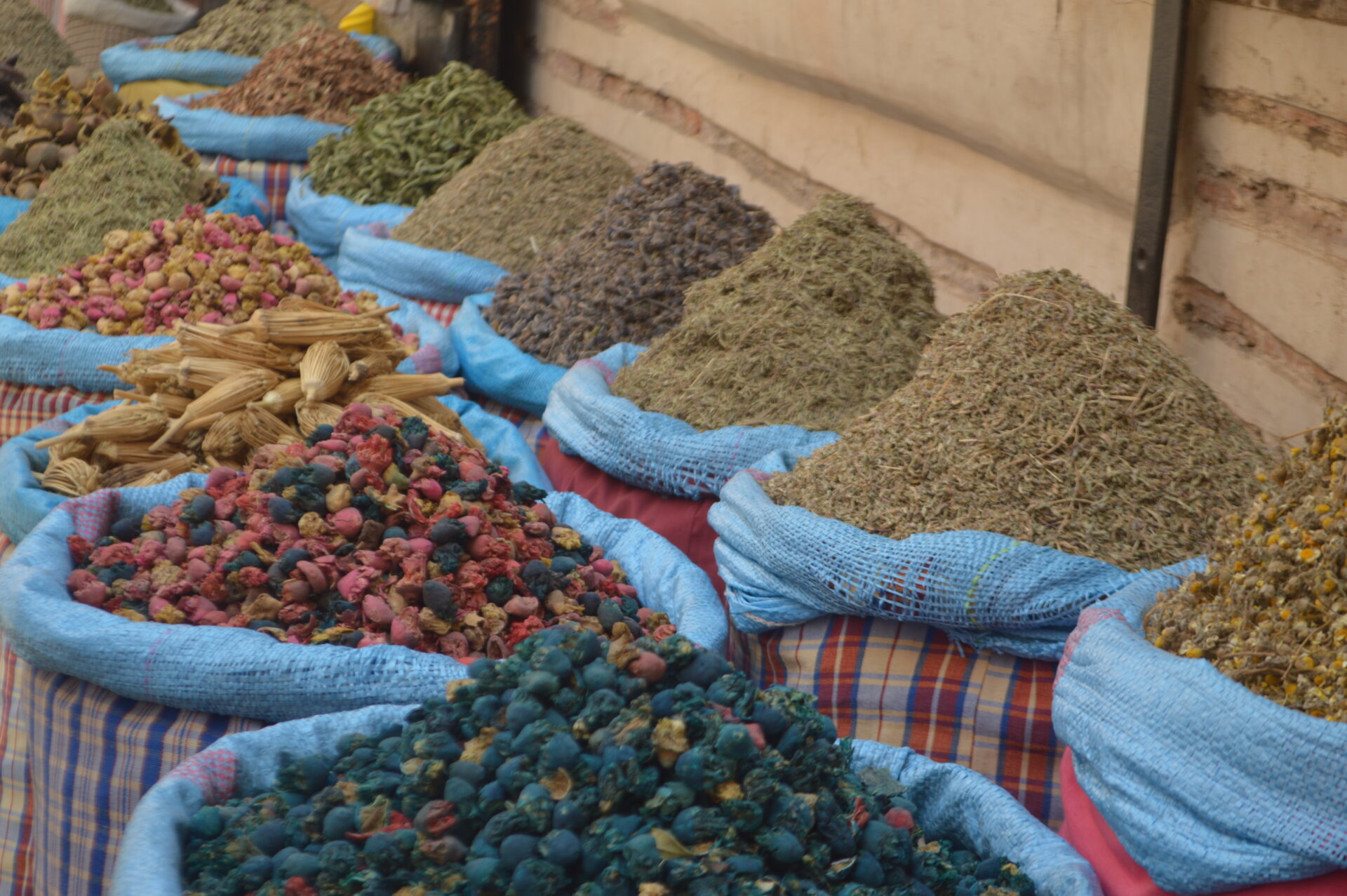
Moroccan spices have a long history. The spice industry in Morocco is changing to match modern preferences. Recently, there has been an increase in unique spice blends, sustainable and organic production methods, and new flavors.
One area of innovation is using traditional Moroccan spices in new and unexpected ways. Chefs and food entrepreneurs are experimenting with unique spice blends and incorporating them into global cuisines, such as harissa paste in Mexican salsas or ras el hanout in a French-style ratatouille.
Moroccan spice farmers employ natural and eco-friendly methods to grow and harvest crops. They use crop rotation, companion planting, and biological pest control practices. These methods benefit the environment and produce higher-quality spices with more complex and nuanced flavors. In addition, there is a growing interest in organic and sustainable spice production.
There are also efforts to promote the unique flavors of Moroccan spices to a broader audience. The Moroccan government is investing in advertising and marketing Moroccan spices abroad, and there are initiatives to establish Moroccan spice certifications and quality standards.
Overall, the future of Moroccan spice innovation looks bright. As consumers continue to seek new and exciting flavors, Moroccan spices are ready to play a crucial role in global cuisine. With a rich history and a commitment to sustainable and organic production methods, Moroccan spices will surely delight taste buds for generations to come.
Conclusion
Moroccan spices are vital to the country’s rich and diverse culinary traditions. People worldwide love these aromatic ingredients used for centuries to create complex and flavorful dishes. By understanding the history, culture, and flavors of these secret ingredients, you can unlock Moroccan cuisine’s secrets and bring this fascinating country’s flavors into your kitchen. Whether you are a seasoned chef or a home cook looking to spice up your meals, Moroccan spices offer endless possibilities for exploration and experimentation.
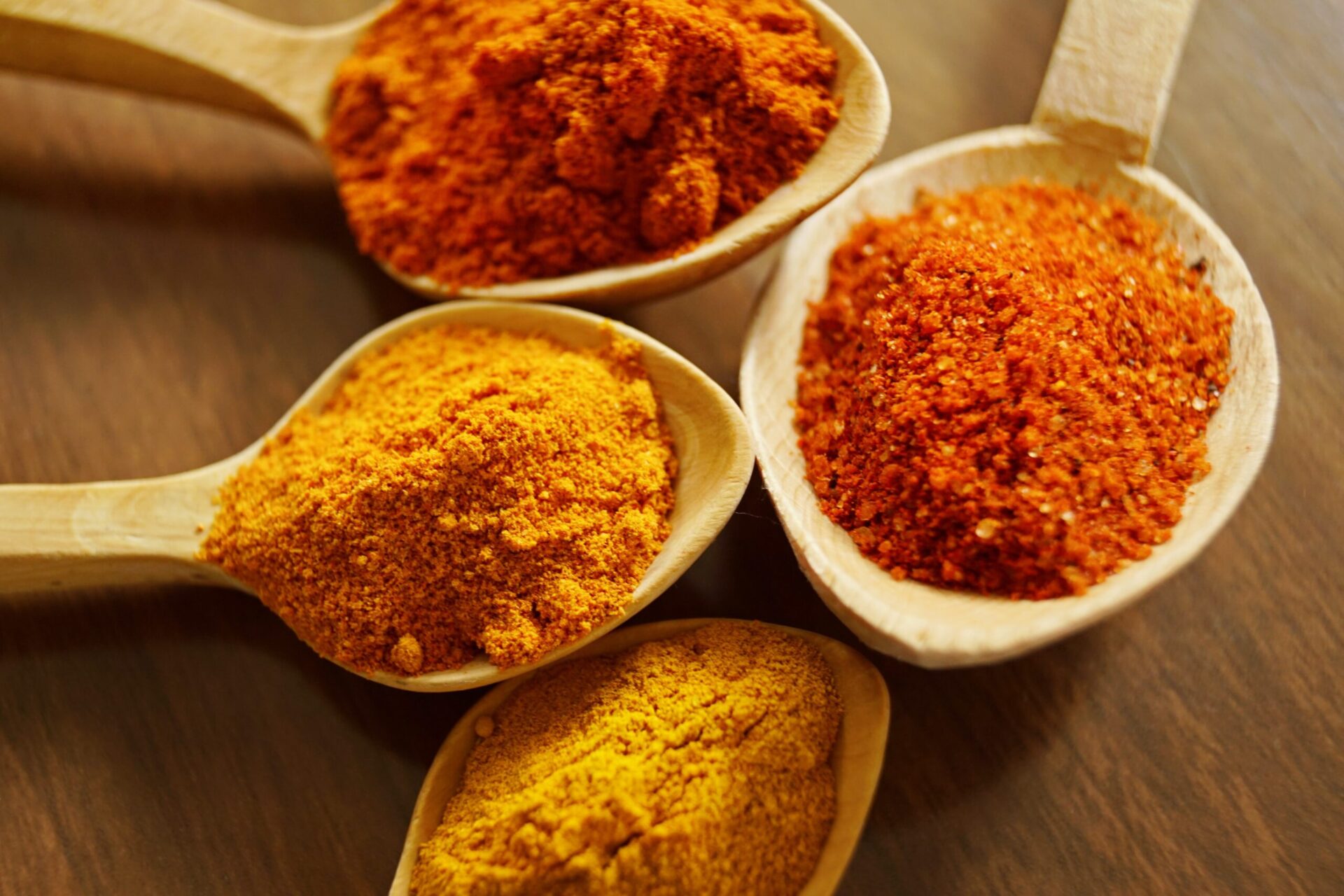

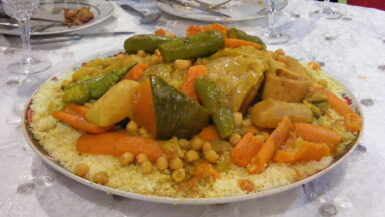
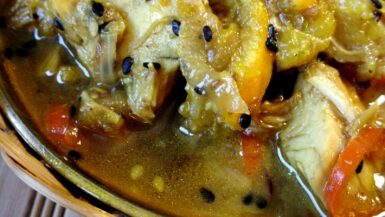
Leave a reply